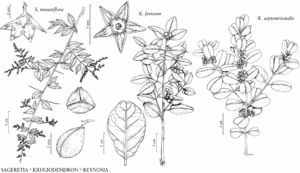Sageretia
Mém. Fam. Rhamnées, 52, plate 2, fig. 2. 1826.
| Taxon | Illustrator ⠉ | |
|---|---|---|
 | Reynosia septentrionalis Sageretia minutiflora Krugiodendron ferreum | Yevonn Wilson-Ramsey Yevonn Wilson-Ramsey Yevonn Wilson-Ramsey |
Shrubs or woody vines [trees], arching, sprawling, drooping, or clambering [erect], tendrils absent, armed with thorns (sometimes not prominent); bud-scales present. Stems not twining, hairy. Leaves persistent or tardily deciduous, present at flowering, usually opposite to subopposite, sometimes alternate distally; blade not gland-dotted; pinnately veined, secondary-veins not strongly parallel [± parallel], tertiary-veins reticulate. Inflorescences terminal and axillary, overtopping or extending beyond foliage, spikelike or spicate, paniclelike thyrses, [5–] 30–120 [–150] -flowered; peduncles and pedicels not fleshy in fruit. Pedicels usually absent, rarely present. Flowers bisexual; hypanthium shallowly cupulate to hemispheric, 1–2 mm wide; sepals 5, erect, yellowish green, triangular, ± fleshy, keeled adaxially; petals 5, white to yellow, hooded, spatulate, short-clawed; nectary fleshy, cupulate, distally free from hypanthium; stamens 5; ovary superior, 2–3-locular; style 1. Fruits drupes; stones (2–) 3, tardily dehiscent.
Distribution
North America, Mexico, se Asia
Discussion
Species 30–35 (3 in the flora).
Most species of Sageretia are from southeast Asia, with 15 endemic to China (Chen Y. L. and C. Schirarend 2007). Four are native to the Americas (G. L. Nesom 1993h).
Selected References
None.
Lower Taxa
Key
| 1 | Shrubs, densely and intricately branched; branches erect or spreading to arching or arcuate-decumbent, densely short-strigillose; leaf blades 0.5–2(–3) × 0.5–1(–2) cm, veins not prominently raised abaxially; inflorescence primary axes 0.5–1 cm, lateral branches 0(–2). | Sageretia wrightii |
| 1 | Shrubs or vines, loosely to compactly branched; branches often becoming sprawling, trailing, or climbing, tomentose or villous-tomentose, sometimes with understory of minute, erect, glandular hairs; leaf blades 1–4.5(–6) × 0.5–2.5 cm, veins prominently raised abaxially; inflorescence primary axes 2–15 cm, lateral branches 4–8. | > 2 |
| 2 | Leaf blade apices acute to acuminate; inflorescence primary axes 5–15 cm. | Sageretia minutiflora |
| 2 | Leaf blade apices acute to obtuse or rounded; inflorescence primary axes 2–5 cm. | Sageretia thea |